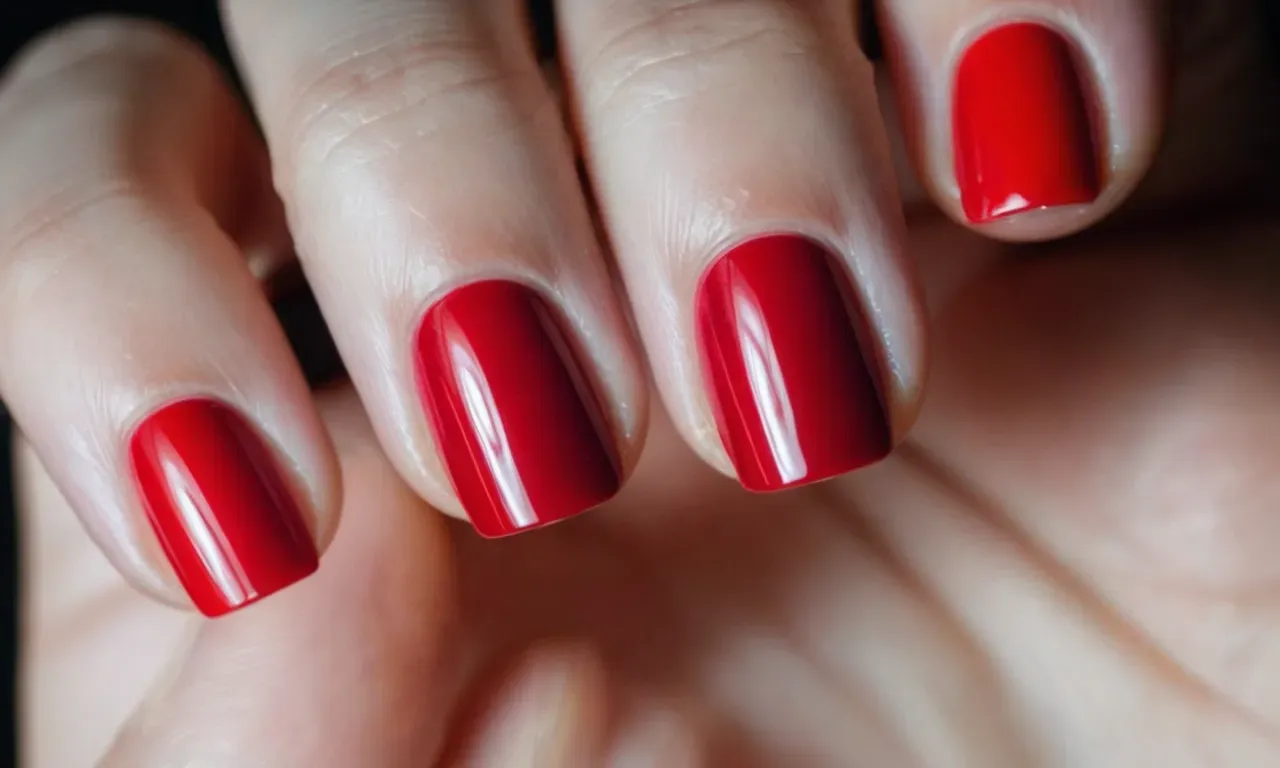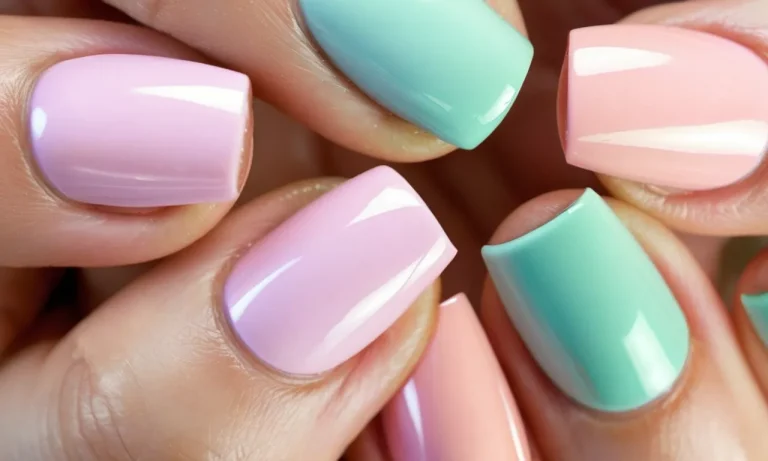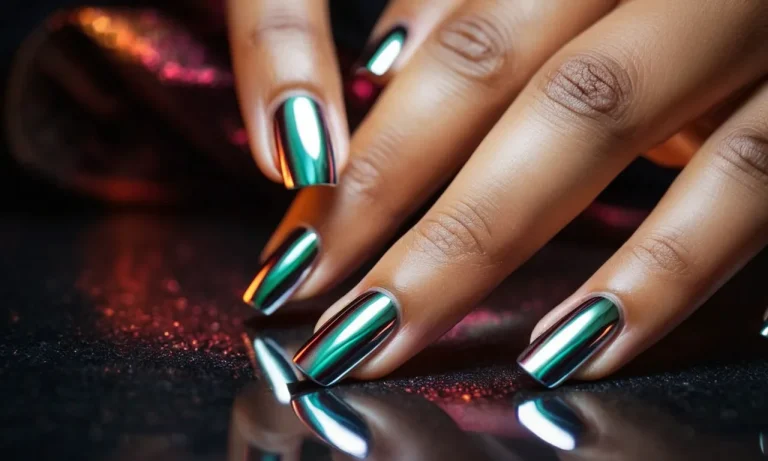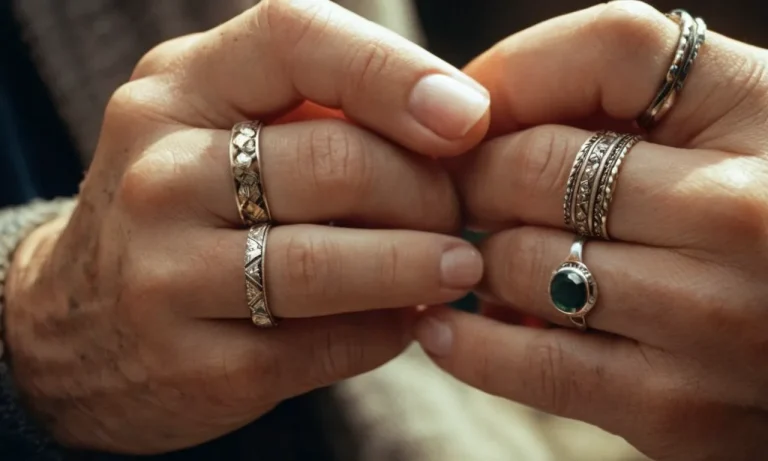Why Do My Acrylic Nails Hurt? Causes And Solutions
If you just got acrylic nails and are wondering why they hurt, you’re not alone. Many people experience pain and discomfort after an acrylic nail application. The good news is that in most cases, the pain is temporary and there are things you can do to relieve it.
Here’s a quick answer: Acrylic nails can hurt due to trauma during the application, allergic reactions, improper application and curing, and other factors. The pain should subside within a few days as your nails adjust.
Using a nail file, taking ibuprofen, applying ice packs, and keeping the nails clean and dry can help relieve discomfort.
In this comprehensive guide, we’ll discuss the common causes of acrylic nail pain and soreness, when you should be concerned about the pain, and some simple solutions to ease the discomfort so you can better enjoy your new nails.
What Causes Pain With Acrylic Nails?
Trauma During Application
During the acrylic application process, the natural nail can become traumatized in several ways, leading to pain and discomfort. Filing or buffing the natural nails too aggressively can cause inflammation and sensitivity (source).
The heat and chemicals used to apply acrylic can also irritate the natural nails and skin around the nails. This trauma can cause short-term pain as well as longer-lasting damages if proper care is not taken.
Allergic Reactions
Some people may have allergic reactions to the acrylic monomers used in acrylic nails or to other chemicals involved in the process. Common allergens include methyl methacrylate and ethyl methacrylate.
Reactions can range from redness and itching to swelling, blistering, and significant pain in the nails and fingers (source). If an allergy is suspected, it’s important to remove the acrylics and avoid further exposure to determine if the reaction subsides.
Improper Application and Curing
Another source of acrylic nail pain arises from improper application or curing techniques. If too much pressure is applied when shaping or smoothing the acrylics, it can cause pain and inflammation. Failing to properly seal the free edge of the enhancement with every fill can lead to cracks and lifting.
If fill intervals are too infrequent, growth pressure builds under the enhancement. Any of these issues can pinch or put pressure on the natural nails, causing significant discomfort.
Lifting and Separation
Over time, acrylic nails may start to lift or separate from the natural nail surface. This creates a gap where debris and moisture can be trapped. As the lifting progresses, the bond between the enhancement and natural nail weakens, which may allow air pockets to form underneath.
The pressure from these pockets pinches the nail bed. Trapped moisture can also allow bacteria or fungus to grow. Both the physical pinching and potential infection can cause redness, swelling, throbbing pain, and sensitivity (source).
Infection
If proper sanitization and disinfection are not carried out during the acrylic application and fill processes, bacteria and fungi can set in, leading to painful infections. One of the most common infections associated with acrylics is onychomycosis, a fungal infection of the nail bed.
Signs include yellowing nails, thickening nails, brittle nails, foul odors, and pain or throbbing sensations (source). Without removing the enhancement, it can be difficult for topical medications to fully clear infections.
When to Be Concerned About Acrylic Nail Pain
Intense, Constant Pain
If you are experiencing intense, constant pain in your nails or nail beds, this is a major red flag that something is wrong. Severe, unrelenting pain that worsens over time often indicates an underlying issue like an infection, allergic reaction or injury.
Don’t try to ignore or ‘push through’ serious acrylic nail pain. Schedule an appointment with your nail tech or dermatologist right away to determine the cause and get proper treatment.
Pain That Gets Worse
Many people feel some mild tenderness or sensitivity after getting new acrylic nails applied. This is normal at first. But if the pain persists for more than a day or two and seems to be getting worse instead of better, that’s a sign of a bigger problem.
Worsening pain can mean you’ve developed an infection, allergic reaction or abscess under or around the nails. It’s important not to wait too long in this situation. See your doctor ASAP to avoid complications like permanent nail damage or loss of the nail.
Signs of Infection
Along with unusual pain, be on the lookout for other symptoms of a nail infection like redness, swelling, throbbing, discharge, foul odor and warmth around the nail(s). An infection can develop if proper sanitization and sterilization procedures weren’t followed during your nail appointment.
Or you may have picked up a fungal infection unknowingly. Either way, a nail infection requires prescription antifungal or antibiotic medication from your physician to clear it up. Trying to treat it at home will only worsen the problem.
While most cases of acrylic nail discomfort are temporary and not a major concern, it’s always best to err on the side of caution. Persistent, worsening or severe nail pain should never be ignored. Schedule an exam with your manicurist, dermatologist or primary care doctor right away if your acrylic nails start to hurt more than they should.
With proper diagnosis and treatment, you can get back to enjoying beautiful, pain-free nails in no time!
Tips to Relieve Acrylic Nail Pain
Use a Nail File
Gently filing your acrylic nails with a soft nail file can help smooth down any rough edges or bumps that may be causing discomfort (source). Focus on filing in one direction and avoid sawing back and forth aggressively. The gentle buffing motion will shape your nails without thinning them.
You can also try gently filing the underside of your nail tip if it feels like it’s digging into your natural nail. Just a light smoothing could provide relief.
Take an Anti-Inflammatory
Popping an over-the-counter anti-inflammatory medication like ibuprofen or naproxen sodium can temporarily reduce acrylic nail pain and swelling (source). Follow the dosage instructions and don’t exceed the recommended amount.
While medication may provide temporary relief, it’s still important to identify and address the underlying cause of the pain for a long-term solution.
Apply an Ice Pack
Applying something cold like an ice pack or bag of frozen vegetables to your fingers can help reduce inflammation and numb any pain (source). Try wrapping the ice in a thin towel and holding it against painful nails for 10-15 minutes at a time.
The cold temperature constricts blood vessels, slowing circulation and providing a numbing effect. Just be careful not to apply ice directly as it could damage your skin.
Keep Nails Clean and Dry
Preventing infection is key to avoiding inflammation and discomfort. Be sure to thoroughly wash your hands and carefully dry your nails after exposure to water. Bacteria and moisture trapped under your nails can cause infections and irritation.
You should also avoid using your nails as tools to scratch, pry, or peel things as this can damage the seal of the acrylic and introduce bacteria (source). Keeping your nails clean, dry, and filed smooth will help prevent painful problems.
When to See a Doctor for Acrylic Nail Pain
Unbearable Pain
Experiencing unbearable or severe pain under or around your acrylic nails is a sign that something is wrong and you should see a doctor. Pain that is throbbing, sharp, or does not go away with typical at-home care like soaking in warm water likely indicates an underlying issue like an infection or allergic reaction.
Don’t try to “tough it out” – severe nail pain usually won’t resolve on its own. Seeking timely medical care can prevent the problem from worsening and allow for proper diagnosis and treatment. The sooner you get examined, the better the outcome will likely be.
Redness, Swelling, Pus
Observing redness, swelling, warmness, or pus around or under the nails points to a possible infection or abscess. The accumulation of pus under the nail is called a paronychia and requires medical attention to avoid complications like permanent nail damage or spread of infection.
Don’t attempt to pop or drain any pus yourself – see a doctor to have the area properly cleaned and treated with antibiotics if an infection is present. Trying to manage these symptoms at home without professional input can risk making things worse.
Loss of Nail or Damaged Nail Bed
If your acrylic nail has partially or fully fallen off, especially if the detachment was sudden or unexpected, it’s important to consult with your doctor or a podiatrist. Rapid nail loss can signify an underlying problem.
Additionally, trauma to the delicate nail bed that leaves it cracked, ripped, or otherwise damaged warrants medical assessment. The nail bed contains many nerves and blood vessels, so injuries to this area should not be taken lightly and need proper care to prevent lasting issues.
Seeking prompt treatment for damaged nails improves the chances that the nails can be repaired and further injury prevented. Don’t wait and hope problems will resolve on their own.
How to Prevent Pain With Future Acrylic Nail Applications
Go to a Reputable Salon
Selecting a reputable and experienced nail salon is crucial for avoiding issues with acrylic nails. Terrific salons employ licensed technicians who are proficiently trained on proper application methods. They use high-quality products and equipment too.
Going to unprofessional salons often leads to problems like lifting, infections, and intense pain from poor applications.
Research salons thoroughly and read reviews before your appointment. A salon with consistent 5-star ratings and glowing customer testimonies indicates the technicians provide exceptional, pain-free services.
You can also check review sites like Yelp to see ratings and what clients say about their acrylic nail experiences.
Ask About Allergy Testing
Some people develop allergic reactions to acrylic nails or products used during the application process. Symptoms include redness, swelling, itching, and significant pain around the nail and cuticles.
Reputable salons will offer allergy testing before an initial full set. This involves placing a small amount of acrylic on your arm to see if any reaction occurs. If you notice anything concerning, technicians can determine the specific ingredient you’re sensitive to and use alternate products for your nails.
Request Proper Filing and Shaping
Most pain from acrylic nails results from incorrect filing and shaping. Over-filing the natural nails and surrounding skin causes sensitivity. And leaving nails too thick or with jagged edges leads to lifting and catching on things, creating pain and potential breakage.
Politely ask the technician to file and shape your nails properly. Well-shaped acrylics follow the natural contour of your nails, are not too thick or thin, and don’t have rough edges. This prevents rubbing, lifting, and other types of irritating pain when wearing your new set.
Care for Nails Properly After
Not properly caring for acrylic nails after your appointment also causes problems. Ensure you keep them very clean, using antibacterial soap each time you wash your hands. Gently pat nails dry with a towel as well.
Use cuticle oil daily to hydrate the skin and nails, preventing painful lifting and cracking. However, avoid getting water trapped under your nails in activities like dishwashing. The moisture becomes breeding grounds for bacteria and fungi, potentially causing infections and pain.
Conclusion
While acrylic nail pain is common, severe or persistent pain should not be ignored. With proper application and nail care, acrylics should not cause major discomfort. Pay attention to any warning signs and see a doctor if pain seems abnormal.
With the right precautions, you can show off beautiful, pain-free acrylic nails for weeks at a time.
We hope this guide gave you a better understanding of what causes pain with acrylic nails and how to find relief. With some simple tweaks and care, your new nails can start feeling fabulous in no time.







